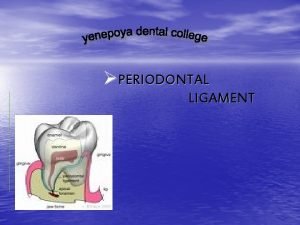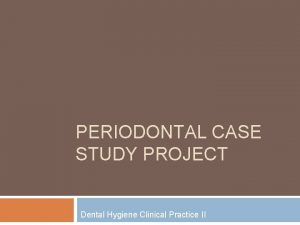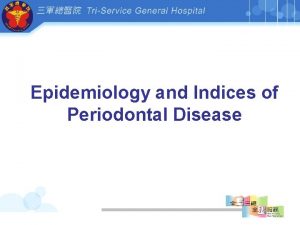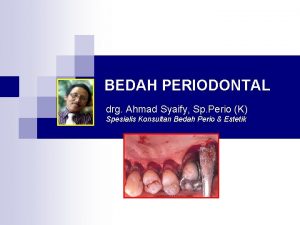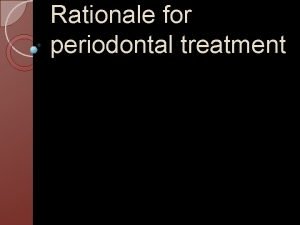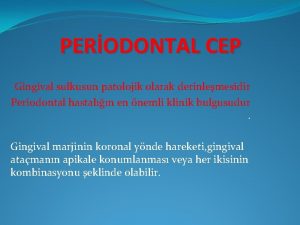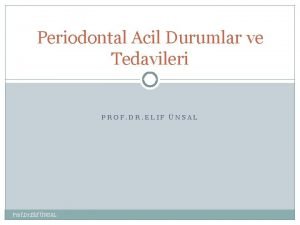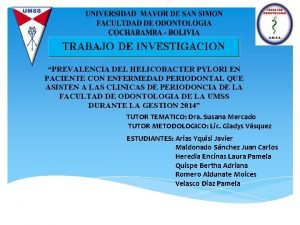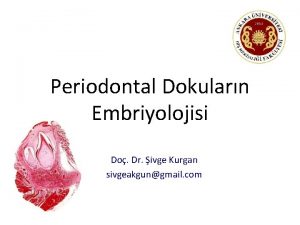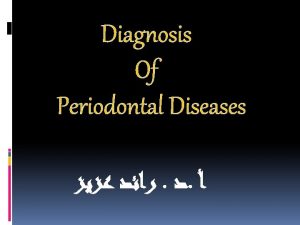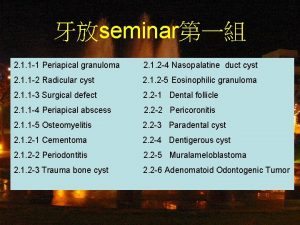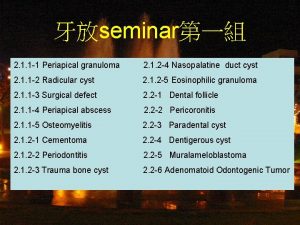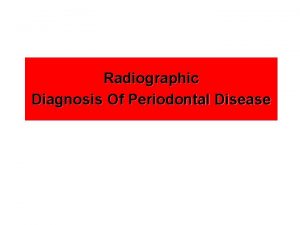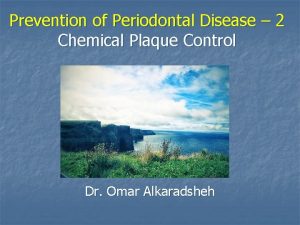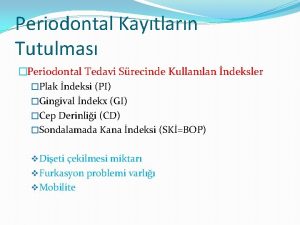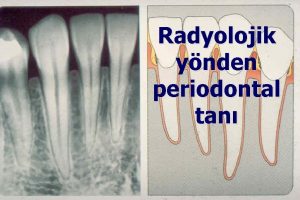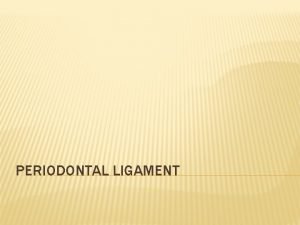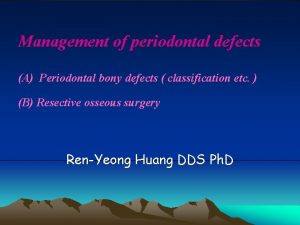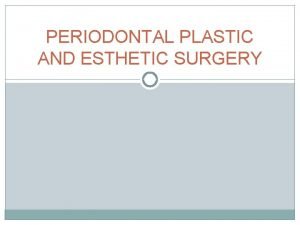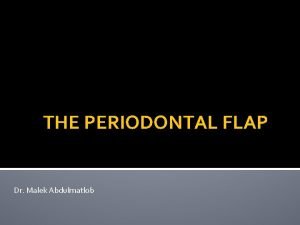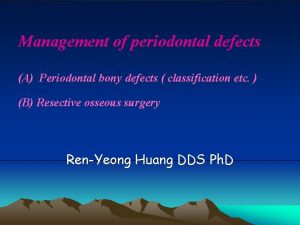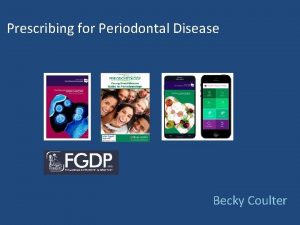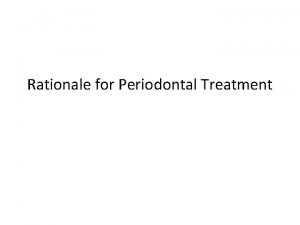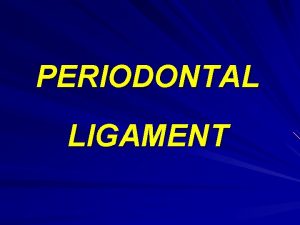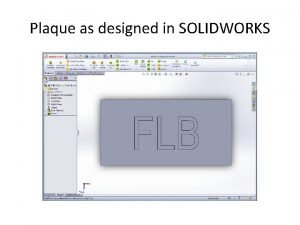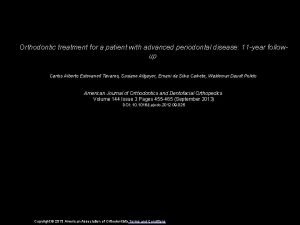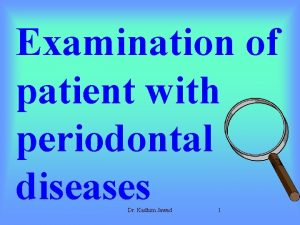PLAQUE CONTROL FOR THE PERIODONTAL PATIENT Plaque control
























- Slides: 24

PLAQUE CONTROL FOR THE PERIODONTAL PATIENT Plaque control is the most essential element of successful periodontal therapy for all patients. Toothbrushing is the one technique that all patients need. Many patients can get effective plaque control using hand brushes, but powered toothbrushes offer improvements for patients that have reduced dexterity or who need a short-term motivational nudge to upgrade their time spent in oral hygiene. Soft nylon bristled toothbrushes directed at the gingival margin and used without a scrubbing motion are the most effective.

Plaque control is the regular removal of microbial plaque and the prevention of its accumulation on the teeth and adjacent gingival surfaces. Microbial plaque is the major etiology of periodontal diseases and is related to dental caries; therefore gaining patient cooperation in daily plaque removal is critical to longterm success of all periodontal and dental treatment.

Carefully performed daily home plaque control, combined with frequent professionally delivered plaque and calculus removal, reduces the amount of supragingival plaque; decreases the total number of microorganisms in moderately deep pockets, including furcation areas; and greatly reduces the quantity of periodontal pathogens.

THE TOOTHBRUSH Toothbrushes vary in size and design as well as in length, hardness, and arrangement of the bristles. Some toothbrush manufacturers claim superiority of design for such factors as minor modifications of bristle placement, length, and stiffness. However, the research does not show significant differences in gingivitis scores or bleeding indices, which are the more important measures of improved gingival health.

Toothbrush Design Toothbrush bristles are grouped in tufts that are usually arranged in three or four rows. Rounded bristle ends cause fewer scratches on the gingiva than flat-cut bristles with sharp ends. Two types of bristle material are used in toothbrushes: natural bristles from hogs and artificial filaments made of nylon. Both remove microbial plaque, but nylon bristle brushes vastly predominate in the market. Bristle hardness is proportional to the square of the diameter and inversely proportional to the square of bristle length. Diameters of common bristles range from (0. 2 mm) for soft brushes to (0. 3 mm) for medium brushes and (0. 4 mm) for hard brushes. Preference for handle characteristics is entirely a matter of taste.



Use of hard-bristled toothbrushes is associated with more gingival recession, and frequent brushers who use hard bristles have more recession than those who use soft bristles. However, the manner in which a brush is used and the abrasiveness of the dentifrice affect the abrasion to a greater degree than the bristle hardness itself. Bristle hardness does not significantly affect wear on enamel surfaces.

The amount of force used to brush is not critical for effective plaque removal. Vigorous brushing is not necessary and can lead to gingival recession, wedgeshaped defects in the cervical area of root surfaces, and painful ulceration of the gingiva.

Recommendations • Soft, nylon bristle toothbrushes clean effectively when used properly, remain effective for a reasonable time, and tend not to traumatize the gingiva or root surfaces. • Toothbrushes need to be replaced about every 3 to 4 months. • If patients perceive a benefit from a particular brush design, they should use it.

POWERED TOOTHBRUSHES Electrically powered toothbrushes designed to mimic backand forth brushing techniques. Currently, powered toothbrushes have oscillating and rotating motions, and some brushes use low-frequency acoustic energy to enhance cleaning ability.

Powered toothbrushes rely primarily on mechanical contact between the bristles and the tooth to remove plaque. The addition of low-frequency acoustic energy generates dynamic fluid movement and provides cleaning slightly away from the bristle tips. The vibrations have also been shown to interfere with bacterial adherence to oral surfaces. Hydrodynamic shear forces created by these brushes disrupt plaque a short distance from the bristle tips, explaining the additional interproximal plaque removal.


Powered toothbrushes have been shown to improve oral health for: (1) children and adolescents, (2) children with physical or mental disabilities, (3) Hospitalized patients, including older adults who need to have their teeth cleaned by caregivers, and (4) patients with fixed orthodontic appliances. Powered brushes have not been shown to provide benefits routinely for patients with rheumatoid arthritis, children who are well-motivated brushers, or patients with chronic periodontitis.

Recommendations • Powered toothbrushes with oscillating and rotating motions remove plaque and reduce gingival bleeding slightly better than manual toothbrushes. • Patients who want to use powered toothbrushes should be encouraged to do so. • Patients need to be instructed in the proper use of powered devices. • Patients who are poor brushers, children, and caregivers may particularly benefit from using powered toothbrushes.

DENTIFRICES Dentifrices aid in cleaning and polishing tooth surfaces. They are used mostly in the form of pastes, although tooth powders and gels are also available. Dentifrices are made up of abrasives (e. g. , silicon oxides, aluminum oxides, and granular polyvinyl chlorides), water, humectants, soap or detergent, flavoring and sweetening agents, therapeutic agents (e. g. , fluorides, pyrophosphates), coloring agents, and preservatives.

Composing 20% to 40% of dentifrices, abrasives are insoluble inorganic salts that enhance the abrasive action of toothbrushing as much as 40 times. The abrasive quality of dentifrices affects enamel only slightly and is a much greater concern for patients with exposed roots.

Dentifrices are very useful for delivering therapeutic agents to the teeth and gingiva. The pronounced cariespreventive effect of fluorides incorporated in dentifrices has been proved beyond question. 119 Fluoride ion must be available in the amount of 1000 to 1100 parts per million (ppm) to achieve caries reduction effects.

“Calculus control toothpastes, ” also referred to as “tartar control toothpastes, ” contain pyrophosphates and have been shown to reduce the deposition of new calculus on teeth. These ingredients interfere with crystal formation in calculus but do not affect the fluoride ion in the paste or increase tooth sensitivity. Dentifrice with pyrophosphates has been shown to reduce the formation of new supragingival calculus by 30% or more. To achieve the greatest effect from calculus control toothpaste, the patient’s teeth must be cleaned and completely free of supragingival calculus when starting to use the product daily.

Recommendations • Dentifrices increase the effectiveness of brushing but should cause a minimum of abrasion to root surfaces. • Products containing fluorides and antimicrobial agents provide additional benefits for controlling caries and gingivitis. • Patients who form significant amounts of supragingival calculus benefit from the use of a calculus control dentifrice.

TOOTHBRUSHING METHODS Many methods for brushing the teeth have been described and promoted as being efficient and effective. These methods can be categorized primarily according to the pattern of motion when brushing and are primarily of historic interest, as follows: Roll or modified Stillman technique Vibratory: Stillman, Charters, and Bass techniques Circular: Fones technique Vertical: Leonard technique Horizontal: Scrub technique



 Patient 2 patient
Patient 2 patient Classification of periodontal instruments
Classification of periodontal instruments Perimylolysis
Perimylolysis Plak boyayıcı ajan
Plak boyayıcı ajan Periodontal ligament meaning
Periodontal ligament meaning Periodontal case study
Periodontal case study Iatrogenic factors in periodontal disease
Iatrogenic factors in periodontal disease Russell periodontal index
Russell periodontal index Fases de la enfermedad periodontal
Fases de la enfermedad periodontal Surgical phase periodontal therapy
Surgical phase periodontal therapy Indikasi gingivektomi
Indikasi gingivektomi Rationale for periodontal treatment
Rationale for periodontal treatment Periodontal cep
Periodontal cep Espacio indiferenciado de black
Espacio indiferenciado de black Periodontal response to external forces
Periodontal response to external forces Non-infective
Non-infective Streptokokal gingivitis
Streptokokal gingivitis Necropulpectomía y biopulpectomía
Necropulpectomía y biopulpectomía Margen gingival
Margen gingival Periodontal ligament meaning
Periodontal ligament meaning Periodontal ligament lifleri
Periodontal ligament lifleri Diagnosis of periodontal disease
Diagnosis of periodontal disease Periapical granuloma
Periapical granuloma Conventional ameloblastoma
Conventional ameloblastoma Periodontal abscess
Periodontal abscess




